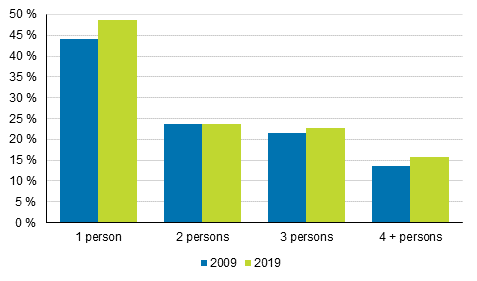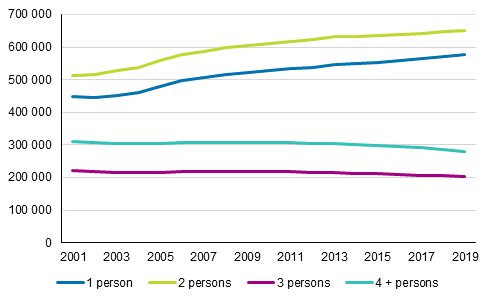Published: 14 October 2020
Rental living of families and persons living alone has become more common
The prolonged growth in the number of household-dwelling units has particularly increased the numbers of household-dwelling units living in rented dwellings. According to Statistics Finland, rental living of persons living alone and household-dwelling units with at least three persons has become more common over the past ten years. Of people living alone, 49 per cent lived in rented dwellings at the end of 2019. Ten years earlier, 44 per cent of those living alone lived in rented dwellings.
Share of household-dwelling units living in rented dwellings by number of persons in 2009 and 2019 (%)

In ten years, the number of household-dwelling units has grown by around 217,000 and at the same time, living in rented dwellings has become more common. In 2019, the share of renting household-dwelling units in all household-dwelling units was 34 per cent, while 30 per cent of all household-dwelling units lived in rented dwellings in 2009. Rental living has become more common particularly among persons living alone and household-dwelling units with at least three persons. Of people living alone, 49 per cent lived in rented dwellings at the end of 2019, the figure being 44 per cent ten years ago. In three-person household-dwelling units the share of those living in rented dwellings was 1.3 percentage points higher in 2019 than ten years earlier. In household-dwelling units with at least four persons, living in rented dwellings has increased by two percentage points in ten years. In two-person household-dwelling units the relative share of rented living has remained unchanged.
Rental living has increased particularly in urban municipalities, where around 39 per cent of household-dwelling units lived in rented dwellings in 2019. In ten years, the share of renting household-dwelling units has risen by around four percentage points in urban municipalities. There is no significant change in the relative share of rental living in rural and semi-urban municipalities. In rural municipalities, around 18 per cent lived in rented dwellings and in semi-urban municipalities 21 per cent.
The number of household-dwelling units living in rented dwellings has increased in ten years by around 160,000, and about 88 per cent of this comes from the growth of those living alone in rented dwellings. Over the same period, the number of household-dwelling units living in owner-occupied dwellings has grown by around 58,000. The number of owner-occupiers has grown in one and two-person household-dwelling units, which is 99,000 household-dwelling units more than in 2009. The number of larger household-dwelling units has fallen, as the number of household-dwelling units with at least three persons living in owner-occupied dwellings is 42,000 lower than in 2009. The changes are partly explained by an increase in the number of one-person and two-person household-dwelling units and by a decrease in the number of large household-dwelling units and families.
Number of household-dwelling units living in owner-occupied dwellings by number of persons in 2000 to 2019

Source: Dwellings and Housing Conditions, Statistics Finland
Inquiries: Anu Rämö 029 551 3450, Arja Tiihonen 029 551 3272, info@stat.fi
Head of Department in charge: Hannele Orjala
Publication in pdf-format (360.6 kB)
- Reviews
-
- 1. Dwelling stock 2019 (14.10.2020)
- 2. Household-dwelling units and housing conditions 2019 (14.10.2020)
- Tables
-
Tables in databases
Pick the data you need into tables, view the data as graphs, or download the data for your use.
Appendix tables
- Appendix table 1. Household-dwelling units by number of persons in 1960 - 2019 (14.10.2020)
- Appendix table 2. Household-dwelling units by housing density on 31 Dec. 2019, by region (14.10.2020)
- Appendix table 3. Household-dwelling units and persons by tenure status in 1970 - 2019 (14.10.2020)
- Appendix table 4. Average floor area (m2) of dwellings in the dwelling stock in 1970 - 2019 (14.10.2020)
- Appendix table 5. Dwelling stock and amenities in 1960 - 2019 (14.10.2020)
- Appendix table 6. 20 - 29-year-old residential population by family status, tenure and region 2005 - 2019 (14.10.2020)
- Appendix table 7. First-time homebuyers in 2006 to 2019 (14.10.2020)
Updated 14.10.2020
Official Statistics of Finland (OSF):
Dwellings and housing conditions [e-publication].
ISSN=1798-6761. Overview 2019. Helsinki: Statistics Finland [referred: 8.12.2025].
Access method: http://stat.fi/til/asas/2019/01/asas_2019_01_2020-10-14_tie_002_en.html

